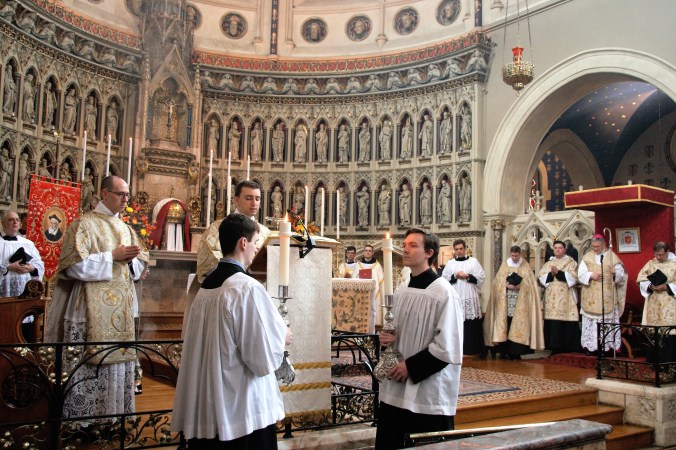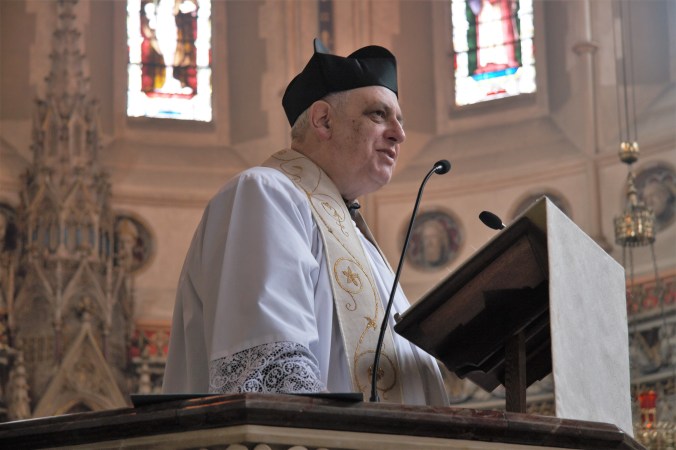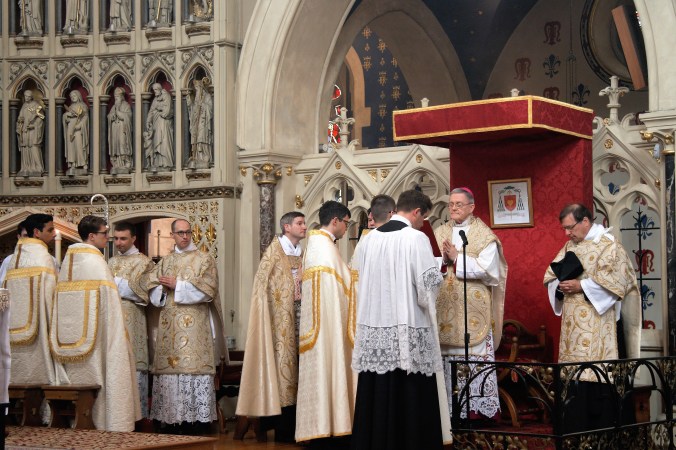
The Gospel read at St. Philip’s Day, the Oratory. Note the exemplary use of lace. (Source)
Last week was, as readers of this blog will no doubt recall, the Feast of St. Philip Neri. Here in Oxford, we made merry with Choral First Vespers, Solemn Lauds, and a Solemn High Pontifical Mass celebrated by His Grace the Apostolic Nuncio to the Court of St. James’s. Amidst all that wonderful liturgy, the homily preached by Fr. Ignatius Harrison of the Birmingham Oratory was perhaps the most memorable moment. I have heard some excellent preaching before. Fr. Ignatius’s words ranks among the most edifying, sound, and apposite pieces of liturgical rhetoric I have ever heard.
Luckily, the full text has been put online at the Oxford Oratory’s website. It starts with the words, “The 16th century heresiarch, Jean Calvin,” and shoots off like a rocket from there.

Fr. Ignatius Harrison, Cong.Orat., preaching for St. Philip’s Day at Oxford. It is always edifying to see a cleric preach wearing the biretta. (Source)
I was especially pleased that Fr. Ignatius placed so much emphasis on the strangeness of St. Philip. The good father is, I think, quite correct in noting that this quality has been blunted and misunderstood by many since the early modern period. We are too quick to claim that St. Philip was just some jovial prankster (and I must say, I think Fr. Faber gets closer to the bone here than Newman—perhaps because Fr. Faber was a bit of a holy loon himself). I had actually been intending to write something on this subject. Now I don’t have to, as Fr. Ignatius has put forth the case so completely and so lyrically.
Is it not dodging the issue somewhat to say that Philip was simply humorous? The plain truth is that he was simply – weird. Nevertheless, for several hours every day, in the confessional, at the afternoon oratory, in his street apostolate, his strangeness somehow managed to interact with the everyday world, though never in a way that could be called completely normal. The supernatural and the praeternatural were always manifesting. His interactions with everyday reality were a real effort for him, a departure from the unearthly invisible realm into which the globe of fire had skewed him in the catacombs, and from which he never fully emerged. Towards the end of his life he admitted that he could stop the palpitating and the shaking if he chose to, but if he did so he was unable to pray…In making Philip Neri a temple of the Spirit, God lifted the veil a little. The Lord allowed something of His otherness to be glimpsed.
It reminded me of what first drew me to St. Philip: his strangeness. I recognized in him something completely different than any other saints I knew, something that gently but firmly turned my mind to the supernatural. I liked St. Philip in the same way I liked Flannery O’Connor or even the Traditional Mass. Here was, Fr. Ignatius’s phrase, the “otherness” of God.
Finally, I’ll add that Fr. Ignatius’s homily is certainly timely. Ross Douthat recently responded to the picturesque blasphemies of the 2018 Met Gala with a call to “Make Catholicism Weird Again.” I have argued much the same point before. The phenomenon known as Weird Catholic Twitter, or WCT, has done a surprising amount of work towards grassroots evangelism. And Traditional or even just middling-orthodox orders, those that stand at odds from the world, are getting lots of vocations. I think it would only be reasonable to grant Fr. Ignatius’s point that we err if we “try and simulate the strangeness, as if it were a regular path to holiness.” But surely a pinch of St. Philip’s oddity is inevitable if we are to stand for the way of sanity in a world gone mad. I can’t bring myself to believe that’s a bad thing.

More of this, please! Even if the world does think we’re a bit strange. (Source)
I have to say, that in this world, this dysfunctional world, which constantly aims only to do “what everyone else does” being a “Catholic” is a weirdness in itself. Where I live, we are ‘those strange Catholics” – the “Roomse gevaar” (Roman Danger) – so no need for any right, left or anything other than true and proper dyed-in-the-wool, born and bred, cradle and convent taught, Latin home (Italian and Spanish parents), kneeling, rosaries and the rest. Magisterium Papist ‘Catholic’ is all that is needed to be known as weird!
LikeLike
Pingback: Prosaic Relics | The Amish Catholic
Pingback: The Charism of Eccentricity | The Amish Catholic
Pingback: St. Philip Neri and the God Who Dwells With Men | The Amish Catholic